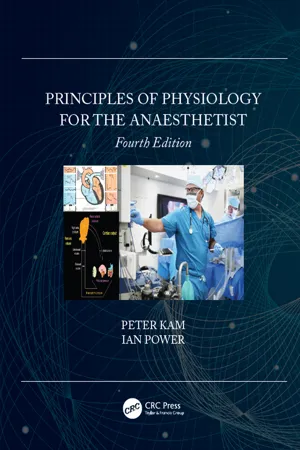
- 511 pages
- English
- ePUB (mobile friendly)
- Available on iOS & Android
eBook - ePub
About this book
This book provides readers with an anaesthesia-focused alternative to general physiology textbooks. The new edition has been reorganised with the trainee anaesthesist in mind, into shorter bite-sized chapters ideal for exam revision. The content includes the physiology of all major organ systems, with specific emphasis on the nervous, respiratory, and cardiovascular systems as well as special sections on pain, aging, specific environments and obesity. Alongside the learning objectives, reflection points and a handy summary of physiological equations and tables, there is greater emphasis on clinical application in this fourth edition, with applied physiology included in almost every section.
Frequently asked questions
Yes, you can cancel anytime from the Subscription tab in your account settings on the Perlego website. Your subscription will stay active until the end of your current billing period. Learn how to cancel your subscription.
No, books cannot be downloaded as external files, such as PDFs, for use outside of Perlego. However, you can download books within the Perlego app for offline reading on mobile or tablet. Learn more here.
Perlego offers two plans: Essential and Complete
- Essential is ideal for learners and professionals who enjoy exploring a wide range of subjects. Access the Essential Library with 800,000+ trusted titles and best-sellers across business, personal growth, and the humanities. Includes unlimited reading time and Standard Read Aloud voice.
- Complete: Perfect for advanced learners and researchers needing full, unrestricted access. Unlock 1.4M+ books across hundreds of subjects, including academic and specialized titles. The Complete Plan also includes advanced features like Premium Read Aloud and Research Assistant.
We are an online textbook subscription service, where you can get access to an entire online library for less than the price of a single book per month. With over 1 million books across 1000+ topics, we’ve got you covered! Learn more here.
Look out for the read-aloud symbol on your next book to see if you can listen to it. The read-aloud tool reads text aloud for you, highlighting the text as it is being read. You can pause it, speed it up and slow it down. Learn more here.
Yes! You can use the Perlego app on both iOS or Android devices to read anytime, anywhere — even offline. Perfect for commutes or when you’re on the go.
Please note we cannot support devices running on iOS 13 and Android 7 or earlier. Learn more about using the app.
Please note we cannot support devices running on iOS 13 and Android 7 or earlier. Learn more about using the app.
Yes, you can access Principles of Physiology for the Anaesthetist by Peter Kam,Ian Power in PDF and/or ePUB format, as well as other popular books in Medicine & Anatomy. We have over one million books available in our catalogue for you to explore.
Section Sixteen
Special Environments
Chapter 77
Physiology Related to Special Environments
Physiology of Diving
Life under water exposes the diver to a major rise in ambient pressure of the environment, with physiological changes and problems from the direct effects of pressure on the body. In addition, the diver must be supplied with a mixture of gases to breathe at a pressure equal to ambient pressure, and this can also give rise to other problems.
Physical laws
As the SI unit for pressure (N/m2 [pascals]) is small, the ‘bar’ has been used for ambient pressures. One bar is equal to 105 N/m2, 750 mmHg and approximately 1 atmosphere (atm). However, in the diving industry, pressure is described in terms of depth in sea water, metres of sea water (msw). For every 10 m under sea water (density, 1.025), there is an increase in ambient pressure of about 1 bar. Thus, assuming that normal atmospheric pressure is 1 bar, at a depth of 50 msw the ambient pressure is 6 bar.
Three physical principles must be used to understand the physiological as well as the pathophysiological effects of life under water. Gases are compressible and follow Boyle’s law. During a breath-hold dive, as the volume of a gas is inversely related to its pressure for a given mass of gas at constant temperature, the volume of air in the lungs decreases with increasing depth and ambient pressure.
As the pressure of the gas increases, its density (mass per unit volume) increases. According to Dalton’s law, an increase in the total gas pressure is ...
Table of contents
- Cover
- Half Title
- Title Page
- Copyright Page
- Table of Contents
- Preface to the first edition
- Preface to the second edition
- Preface to the third edition
- Preface to fourth edition
- Acknowledgements
- Authors
- Contributors
- Section One: Basic Cell Physiology
- Section Two: Physiology of the Nervous System
- Section Three: Muscle Physiology
- Section Four: Respiratory Physiology
- Section Five: Cardiovascular Physiology
- Section Six: Gastrointestinal Physiology
- Section Seven: Liver Physiology
- Section Eight: Renal Physiology
- Section Nine: Acid–Base Physiology
- Section Ten: Physiology of Blood
- Section Eleven: Physiology of the Immune System
- Section Twelve: Endocrine Physiology
- Section Thirteen: Metabolism, Nutrition, Exercise and Temperature Regulation
- Section Fourteen: Physiology of Pain
- Section Fifteen: Physiology of Pregnancy, Placenta, Neonate, Ageing and Obesity
- Section Sixteen: Special Environments